Related Research Articles

The Kingdom of Travancore, also known as the Kingdom of Thiruvithamkoor, was an Indian kingdom from c. 1729 until 1949. It was ruled by the Travancore Royal Family from Padmanabhapuram, and later Thiruvananthapuram. At its zenith, the kingdom covered most of the south of modern-day Kerala and the southernmost part of modern-day Tamil Nadu with the Thachudaya Kaimal's enclave of Irinjalakuda Koodalmanikyam temple in the neighbouring Kingdom of Cochin. However Tangasseri area of Kollam city and Anchuthengu near Attingal in Thiruvananthapuram were parts of British India.

Rama Varma I often referred to as Dharma Raja, was the Maharajah of Travancore from 1758 until his death in 1798. He succeeded his uncle Marthanda Varma, who is credited with the title of "maker of modern Travancore". During his reign Dharma Raja not only retained all the territories his predecessor had gained but administered the kingdom with success. He was addressed as Dharma Raja on account of his strict adherence to Dharma Sastra, the Hindu principles of justice by providing asylum to thousands of Hindus and Christians fleeing Malabar during the Mysorean conquest of Malabar.

Kunnathur Kesavan Raman Pillai, also known as Raja Kesavadas was the Dewan of Travancore during the reign of Dharma Raja Karthika Thirunal Rama Varma. He is well known for his military tactics and administrative acumen. He was the mastermind in developing the Alappuzha town.

Velayudhan Chempakaraman Thampi ofThalakulam (1765–1809) was the Dalawa or Prime Minister of the Indian kingdom of Travancore between 1802 and 1809 during the reign of Bala Rama Varma Kulasekhara Perumal. He is best known for being one of the earliest individuals to rebel against the British East India Company's authority in India.
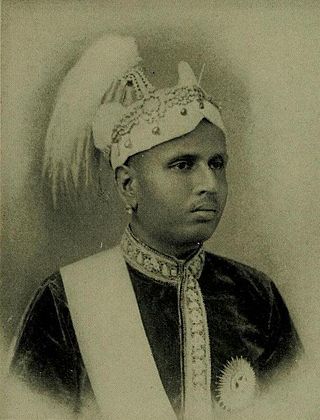
Sir Moolam Thirunal Rama Varma (1857–1924) was Maharajah of the princely state of Travancore between 1885 and 1924, succeeding his uncle Maharajah Visakham Thirunal (1880–1885). Moolam Thirunal is considered as the first in Indian to implement the concept of public participation in governance through the formation of Travancore Legislative Council.
Mar Dionysius I (Mar Thoma VI) (died 8 April 1808), was the 6th Metropolitan of the Malankara Syrian Church from 1765 until his death. A member of the Pakalomattom family (Thazhmon, Ayroor) he appealed to outside authorities to assert his position as the sole leader of the Malankara Church and to attempt to reunite all the Saint Thomas Christians.
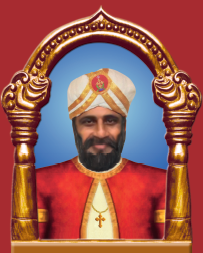
Thachil Mar Matthoo Tharakan (1741–1814) was a Saint Thomas Christian merchant, social leader and minister who played a key role in Kerala, especially in its Travancore and Cochin regions, in India towards the latter part of the 18th century and early 19th century. He relentlessly worked to bring about a reunification in his community which was divided into Catholic (Pazhayakūr) and Jacobite (Puthenkūr) after the Coonan Cross Oath of 1653. He organized his community against the colonialist attempts of Portuguese and played a prominent role in the assembly of Catholic Saint Thomas Christians at Angamāly that paved the way for the establishment of independent Syro-Malabar hierarchy.

Maharani Ayilyom Thirunal Gouri Lakshmi Bayi (1791–1815) was the Maharani of the Indian state of Travancore from 1810 till 1813 and Regent from 1813 till her death in 1815 for her son Swathi Thirunal Rama Varma. She was the only Queen of Travancore to have reigned in her own right which she did for two years before becoming a regent.

Uthrittathi Thirunal Gowri Parvathi Bayi (1802–1853) was the Regent of the Indian state of Travancore in 1815–1829. She succeeded her sister Maharani Gowri Lakshmi Bayi, till her regency was relinquished in favour of her nephew, Maharajah Swathi Thirunal.

Visakham Thirunal Rama VarmaFRAS was the Maharaja of the erstwhile Indian kingdom of Travancore from 1880 to 1885 AD. He succeeded his elder brother Maharajah Ayilyam Thirunal to the throne of Travancore.

The Travancore royal family was the ruling house of the Kingdom of Travancore. They had to give up their ruling rights in 1949 when Travancore merged with India and their political pension privileges were abolished in 1971. The family is descended from the Ay/Venad family and the Chera dynasty.
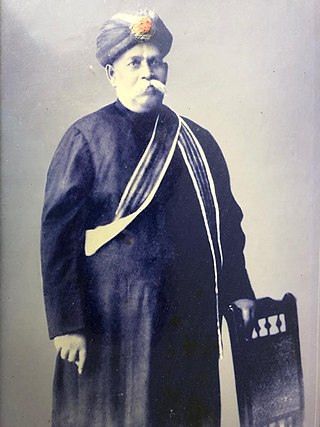
Diwan Bahadur Sir Veeraraghavapuram Nagam Aiya was an Indian pioneer, historian, civil servant, and chronicler who served as the Dewan in the erstwhile princely state of Travancore.
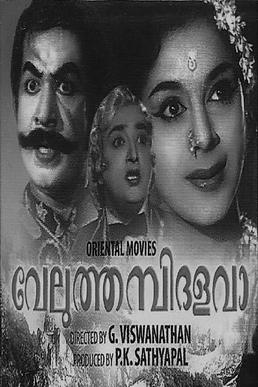
Veluthampi Dalawa is a 1962 Malayalam-language historical drama film based on the life of Velu Thampi Dalawa, the Dewan of Travancore during the first decade of 19th century, was one of the first to rebel against the British East India Company's supremacy. The film, directed by G. Viswanath and written by Jagathy N. K. Achary was shot in Newton Studios. Kottarakkara Sreedharan Nair, Thikkurissy Sukumaran Nair, Prem Nawas, Adoor Bhasi, G. K. Pillai, Ragini, Ambika Sukumaran and Sukumari portrayed prominent roles. The dances were choreographed by Chinni and Sampath along with Kalamandalam Madhavan. The film was a box office success.
Parappanad was a former feudal city-state in Malabar, India. The headquarters of Parappanad Royal family was at the town Parappanangadi in present-day Malappuram district. In 1425, the country divided into Northern Parappanad and Southern Parappanad. Southern Parappanad included parts of Tirurangadi Taluk and the town Parappanangadi. Northern Parappanad included Panniyankara, Beypore, and Cheruvannur of Kozhikkode Taluk. Parappanad royal family is a cousin dynasty of the Travancore royal family.
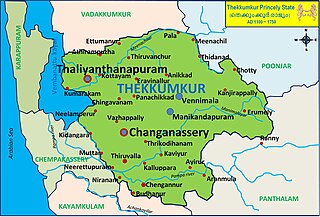
The Battle of Changanacherry was a battle between the kingdoms of Thekkumkur and Travancore in September 1749. Defeat in this decisive battle led to Thekkumkur losing its dominance and expanding the Tranvancore empire to the southern border of the river Meenachilar.

Neerazhi Palace was the royal palace of the Thekkumkur kingdom. Palace is located at Puzhavathu in Changanassery. The palace was used by the Thekkumkur dynasty until 1750 and later by the Parappanad dynasty who settled in Changanassery from North Malabar. It was here that the last king of Thekkumkur, Aditya Varman Manikandan escaped to Nattassery of Kottayam in the Travancore invasion of 1790. The Neerazhi palace was earlier known as Neerazhikettu.

Lakshmipuram Palace is the royal palace of the Parappanad royal families at Changanassery. Palace is located at Puzhavathu near to Kavil Bhagavathy Temple. The Lakshmipuram Palace was built in 1811 AD by Travancore ruler Maharani Ayilyom Thirunal Gouri Lakshmi Bayi (1791–1815) on behalf of the family of her husband Raja Raja Varma Valiya Koil Thampuran. Until then, the royal family at the Neerazhi Palace in Changanacherry had been moved to newly built Lakshmipuram Palace. It was the seat of the royal family of Koi thampurans and has produced many illustrious writers such as Raja Raja Varma Koil Thampuran, Kerala Varma Valiya Koil Thampuran and A. R. Raja Raja Varma. Noted Malayalam singer and classical musician L. P. R. Varma also hails from this palace.

Aditya Varma Manikandan popularly known as Aditya Varman, was the last ruling Maharaja of the Princely State of Thekkumkur. He was the ruler until September 1749 when the king of Travancore Anizham Thirunal Marthanda Varma ousted him from Neerazi Palace at the Battle of Changanassery. Thekkumkur kings were known as Manikandan. The goddess was Cheruvally Bhagavathi in the space. The official residence of Sri Aditya Varma was Neerazi Palace.